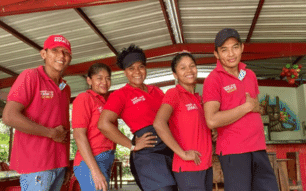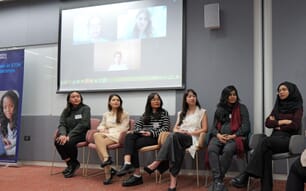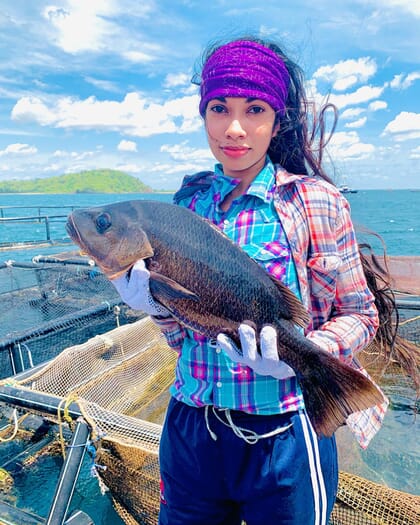
Can you briefly describe your career?
I graduated from the Ocean University of Sri Lanka with a bachelor of science in fisheries and marine sciences and a gold award. After that, I worked as an assistant manager for seafood quality assurance at a marine fish processing company. I was lucky to receive funding from the Nor-Lanka project, a collaboration between Norway and Sri Lanka, to pursue a master’s degree in fish ecotoxicology at the Arctic University of Norway. I did my thesis in Sri Lanka on tuna processing to get hands-on experience.
After my studies, my goal was to pursue a career in marine aquaculture and was offered a position as a marine aquaculture specialist at Oceanpick, the first offshore finfish farm in Sri Lanka. I started as a technician, then got promoted to assistant manager, and currently I work as onshore production manager which means that I manage the hatchery and nursery operations for barramundi (Asian seabass).
Why did you choose a career in aquaculture?
Since I was a child, I have always loved the sea and my wish was to live near the ocean. My father taught me how to swim and dive, as he wanted me to build a connection with nature. He often took me to the sea to go snorkelling and admire the underwater world. This is where my passion for marine life comes from and why I chose to study marine sciences. When I was in Norway, I visited a marine cage farm for the first time, and I thought, this is it, this is what I want to do with my life. In aquaculture I can combine my interest in science with my love for the ocean. Besides, I wanted to bust the Sri Lankan myth that girls are unfit for the marine aquaculture sector.
What characterises the aquaculture sector in Sri Lanka?
Sri Lanka is a small country surrounded by the sea, which is mostly used for tourist activities, not so much for aquaculture. The main aquaculture production is done inland in brackish and freshwater ponds, which culture carp and tilapia. Being an island with pristine waters all around, Sri Lanka has the perfect conditions or marine aquaculture. However, Oceanpick remains the only player in marine aquaculture in Sri Lanka. The company produces around 2,000 tonnes of Asian seabass per year.
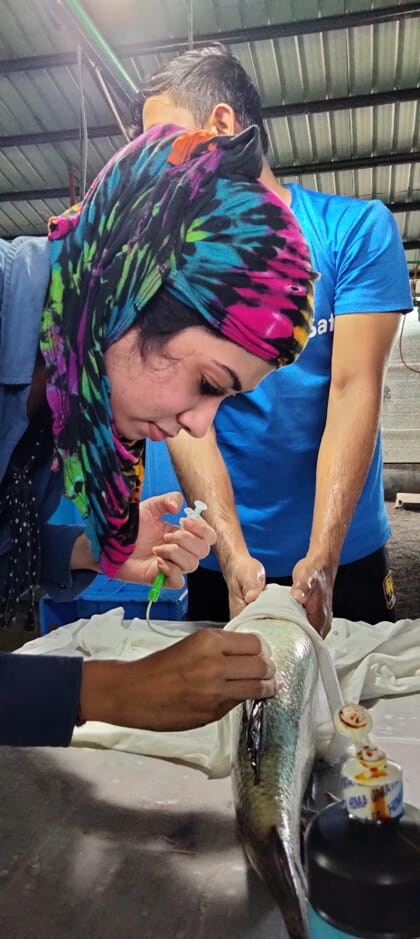
What does a typical day consist of for you?
My daily tasks include management of broodstock, larval rearing, live feed production, nursery management, and fingerling transfer. I am also responsible for maintaining optimum water quality in the systems to ensure fish health and better growth. I also plan feeding and grading schedules and check the health status of fish. Finally, I take care of staff schedules and training for the work in the hatchery and nursery.
What is your favourite part of working in aquaculture?
My favourite part of the job is to see the fish developing, starting with the egg all the way to fingerling. It is fascinating to see eggs develop into healthyWhat does a typical day in your current role consist of? fish, despite their hardships. It is a challenge to produce high quality fish fry. Everything must be precise, starting with the egg collection at the right time, following the correct procedure. We need to syphon, manage the water flow, and provide quality live feed to reach a high survival rate. But this is also what keeps the work interesting.
What work-related achievement are you most proud of?
I produced over a million fish in a facility with a capacity of 300,000 fingerlings using a very low water exchange rate. Furthermore, we developed smart techniques that use biotools to immunise fingerlings against pathogens. These methods increase survival in the cages significantly. We also feed the broodstock and fingerlings with cactus flowers to reduce stress and promote spawning in broodstock.
What challenges have you encountered working in the sector?
We encounter the usual challenges such as disease outbreaks, climate change impacts and global supply constraints. Sometimes the broodstock do not spawn or the eggs are unfertilised. This can be due to climate change or other environmental factors. We have solved this problem by using recirculating aquaculture to maintain an optimal water quality. We also encounter problems with the supply of products we use in the hatchery. A lot of them are imported and do not always reach us on time. For example, we were not allowed to import Chlorella, which is what we used to feed to the rotifers, so we had to use Nannochloropsis or yeast as alternatives.
Have you encountered any gender-related challenges in the sector?
Initially, it was quite hard to work in a place always surrounded by men. Sri Lanka is still very traditional and conservative. The marine aquaculture industry is still a male domain with limited representation of women in key research and leadership roles. Men are not ready to listen to a woman in charge. When I first started, I saw them thinking, what is this girl doing here? However, once they saw I can do the job, and did all the tasks they did, they started to accept and respect me in my role.
I also faced strong resistance from my parents. As an only child they were worried for me, living in an isolated place in a world of men, going on boats and doing night shifts when girls in Sri Lanka are expected to be housewives. Fortunately, they have accepted my job and are now encouraging and helpful. When I come home, they cannot wait to hear my stories since my job is adventurous and unique. I am also proud to say that more and more female students are coming for an internship at our company, so I feel like I am making a difference already.
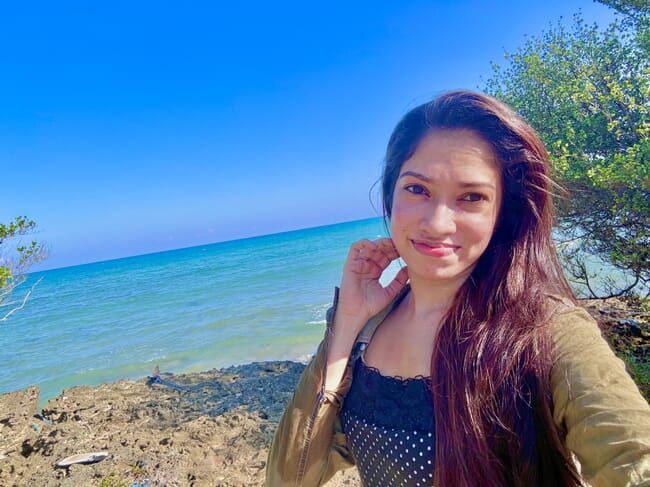
Are there any individuals or organisations in aquaculture that you’ve found particularly inspirational?
My boss, Aslam Pathiri, who is from India. He is a marine aquaculture leader with 16 years of global experience. He really boosted the production at Oceanpick and I learned a lot from him. He deservedly was recognised in the Top 10 hatchery professionals under 40 by Hatchery International.
What’s the most unusual experience you’ve had in aquaculture?
We have a project to collect wild broodstock of groupers and snappers as we are planning to produce them in the future. We mobilise and train traditional fisher folk to collect, handle and rear breeders in pens. It was quite challenging to convince them to transfer the fish to the pens, instead of harvesting them, and to teach them the proper practices. For example, they first arrived with small buckets and basins in which they planned to transfer fish without adding oxygen, resulting in high mortalities. Therefore, I created a portable cage that can be dragged through the water to move the fish. This helped and they collected enough fish to start our breeding programme.
If you could solve one issue in aquaculture, what would it be?
I would like to reduce diseases in fish by developing commercial immunisation protocols for the main pathogens.
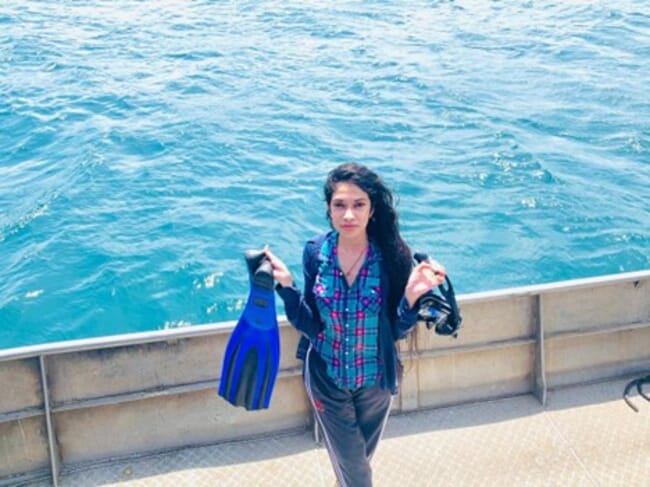
What advice would you give to women who are considering joining the aquaculture sector?
No matter how highly educated we are, to understand aquaculture methods from the fundamentals to the advanced levels, you must first exercise humility and patience. Additionally, you must cultivate a mind that is willing to make sacrifices and work around the clock. Working with live animals you always need to keep your five senses alert because anything can happen at any time. That said, I believe that women’s innate ability to nurture and feel maternal emotions are an advantage in the work in the hatchery and nursery.
What would you like to be doing in 10 years’ time?
I want to stay in the marine aquaculture sector, and it would be great to be a globally recognised marine aquaculture leader. Aquaculture is one of the most valuable sectors in the world. With the increasing protein demand and dwindling wild fish stocks, sustainability will become more important. I believe this is the way forward for the sector and I would be happy to play a role in it.


